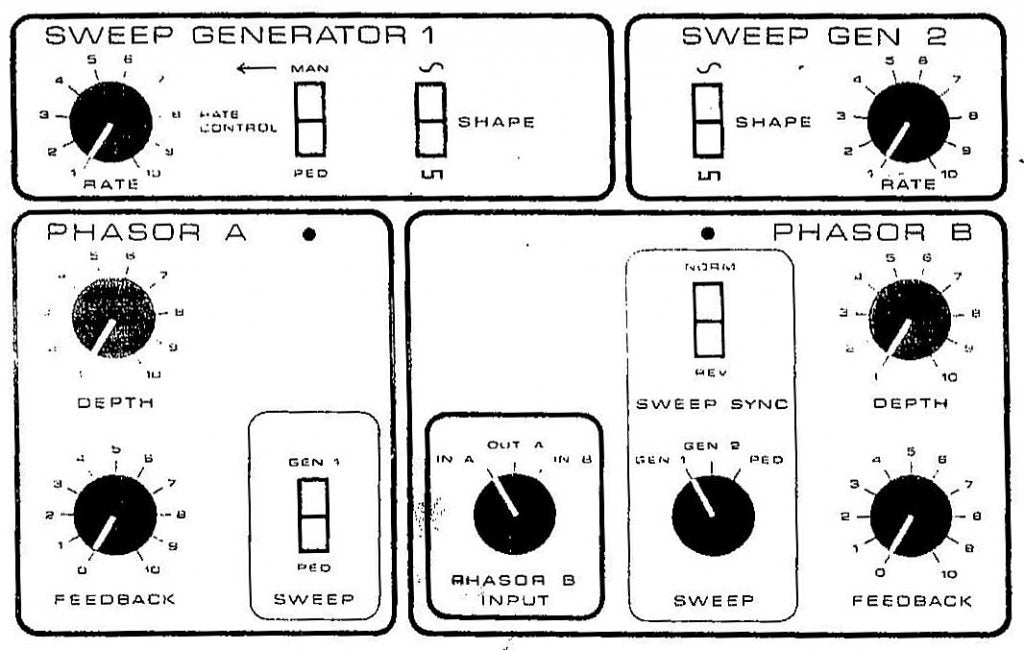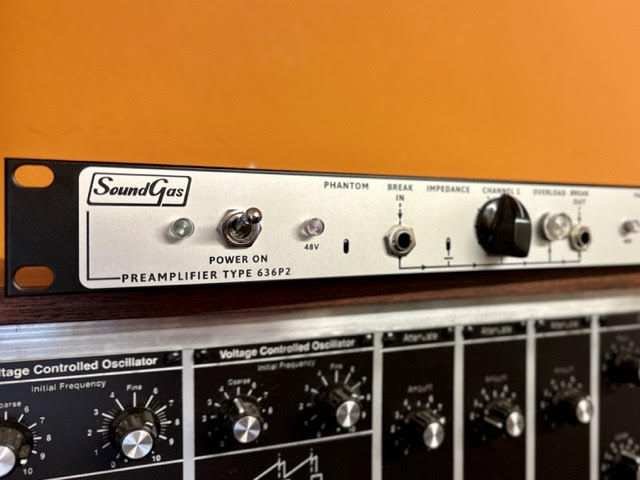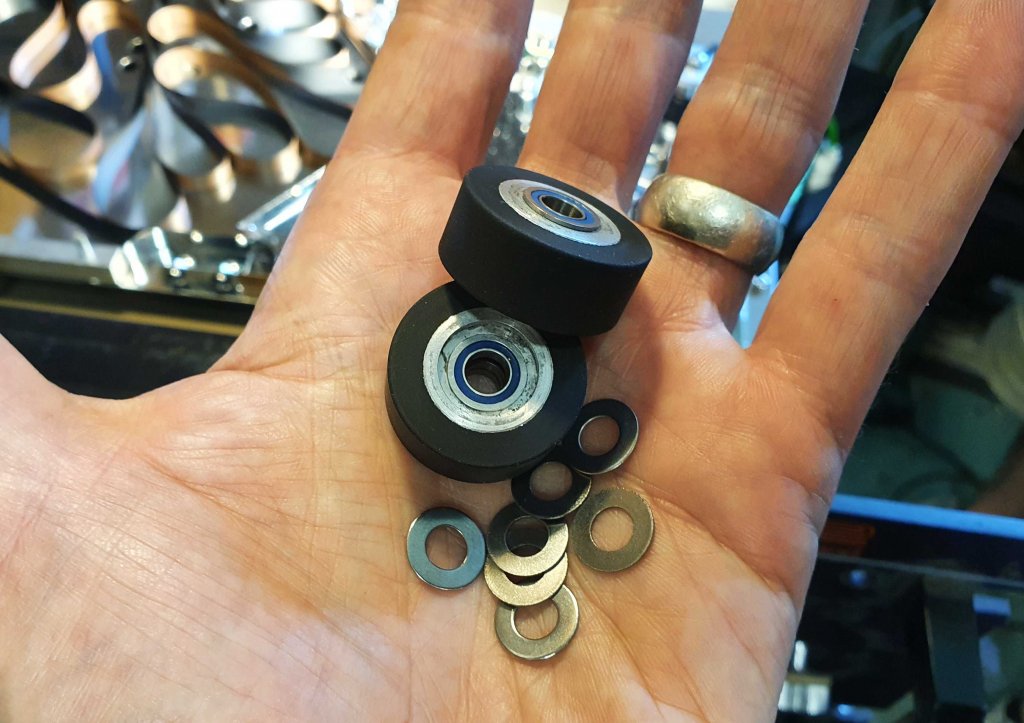
Mu-tron Bi-phase Owners Manual
Complete text of the original Bi-phase manual. The Mu-tron Bi-phase isn’t necessarily our absolute “favourite” phaser – we have a great many flavours of phase to choose from, including the Schulte Compact Phasing ‘A’, and various original MXR/Ehx pedals – or one from the racks (AMS, Moog, Eventide…). But there’s no escaping the fact that it’s often the one we reach for because it’s so versatile, sounds superb, and in many circumstances it’s just the perfect tool for the job.
Visit our in-depth Mu-tron Bi-phase page; plus we also have downloadable versions of the original Bi-phase settings sheets (including a blank one).
A pdf version of this manual can be found on the Mu-tron website.
INTRODUCTION
The Mu-tron Bi-Phase is a sophisticated and versatile sound modification device which consists of two independent six-stage phase shifters. Both phasors have complete control flexibility, and this, combined with some sophisticated switching and control functions, gives the musician an extremely wide range of effects including many that are simply not possible even with two conventional phasors. However, this same total flexibility means that there are quite a few controls the user must become familiar with before he masters the operation of the Bi-Phase. The musician who takes the time to study this manual and learn the functioning of each control will be well on his way toward understanding the subtleties of the Bi-Phase.
The range and number of effects possible with the Bi-Phase is virtually limitless, and this manual is intended to give the musician a starting point for his own experiments into the creative possibilities of this device. It begins with a description of each control and its function followed by general operating instructions and descriptions of the basic modes of operation.
CONTROLS
The graphics of the Mu-tron Bi-Phase have been designed to visually reflect the functional relationships of the various controls as much as possible. Each of the two sweep generators and two phasors are marked off by silver outlines. The “Shape” switch and the three main controls for Sweep Generator 1 and Phasor A are exactly duplicated in the other half of the Bi-Phase. The switches controlling the sweep source for each phasor are located in black blocks on the panel, and the unique “Phasor B Input” switch is in a block outlined in black.
BYPASS FOOT SWITCHES: Two foot switches are provided in a single housing to allow each of the two phasor sections to be turned on and off individually. Each phasor section has a LED indicator light on the panel to show when it is in operation. NOTE: The phasor circuits will not operate unless the foot switch unit or the optional foot pedal/foot switch is plugged in via the back panel connector.
RATE CONTROL: Two rate controls are provided to independently control the speed of each sweep generator. Each control smoothly and continuously varies the sweep rate-from 0.1Hz (10 seconds per sweep cycle) to 18Hz. At the higher speeds, an interesting pseudo-ring modulation effect results, particularly if the ‘Feedback’ controls are turned up.
RATE CONTROL SWITCH: This switch allows the user to control the rate of Sweep Generator 1 either with the knob on the panel or with the optional foot pedal. If the switch is in the “Ped” position and the pedal is not plugged in, the Sweep Generator operates at a very tow rate.
SHAPE CONTROL: A rocker switch is provided to choose between sine-wave and square-wave sweep on each sweep generator. In the sine-wave position, the Bi-Phase produces the familiar, smoothly-swept phasing effect, while the square-wave sweep jumps the phasing from one extreme of the sweep to the other. At moderate rates with the “Feedback” control turned up, square-wave phasing resembles an echo repeat.
DEPTH CONTROL: The “Depth” controls, along with the ““Feedback”’ controls, determine how deep the phasing effect sounds. Normal phasing consists of a series of cancellations or dips in the frequency response curve which are swept up and down in frequency. The Depth” control continuously varies the width of the frequency range these dips are swept over, from a narrow (or shallow) sweep at ‘1’ to maximum width {or depth) at 10,” At lower speeds, the smoothest-sounding phasing is found at about “8”; as the rate is increased, it will probably be necessary to reduce the depth somewhat to maintain a smooth-sounding phasing effect, although this is a matter of taste and what effect you are looking for.
FEEDBACK CONTROL: These controls are unique to the Bi-Phase. In a sense what they control is the intensity of the Phasing effect you hear, At ’‘0” the Bi-Phase produces the normal sweeping cancellations described above; as the “Feedback” control is turned up, electronic feedback is added, creating positive peaks in the frequency response in between the cancellations or dips. This has the effect of increasing the definition and emphasis of the phasing effect. This emphasis is particularly useful for maintaining definition of the effect at very slow phasing rates. At full feedback, the Bi-Phase will pick out the individual notes and harmonics of a chord as it sweeps up and down; when using the optional foot pedal in the pedal-sweep mode, full feedback results in a sound resembling a very unusual wah-pedal.
PHASOR A SWEEP SWITCH: This rocker switch allows the user to choose a between Sweep Generator 1 and the optional foot pedal as the source of the sweep for Phasor A. In the “Gen 1” position, Sweep Generator 1 supplies a varying voltage which sweeps Phasor A back and forth. In ‘‘Ped’” the optional foot pedal is the source of the varying voltage. The pedal only varies the voltage (and sweeps the phasor) if the pedal is being moved up and down; if the switch is in “Ped” and the pedal is not moved, or if the pedal is not plugged in, the Bi-Phase changes the timbres (or tone) of the sound but does not sweep back and forth.
PHASOR B SWEEP SWITCH: This three-position rotary switch has a function similar to the Phasor A “Sweep” switch except that it offers Sweep Generator 2 in addition to Sweep Generator 1 and Pedal. If both phasors are swept by Sweep Generator 1, their sweeps will be exactly synchronized; this can be used to produce double-depth or stereo effects. The same is true of using both phasors in the ‘‘Ped” position. If different sweep sources are used, for example Generator 1 for Phasor A and Generator 2 for Phasor B, a very wide range of two-speed effects is possible.
SWEEP SYNC SWITCH: If both phasors are being swept by the same source (either Sweep Generator 1 or the optional pedal) their sweeps wilt be synchronized. The ‘‘Sweep Sync’’ switch allows the user the choice of synchronizing exactly or reversing the direction of Phasor B relative to Phasor A, In other words, in the ’’Rev” position, Phasor B will be sweeping downward in frequency as Phasor A-sweeps upward. This is the basic means of generating stereo phasing effects.
PHASOR B INPUT SWITCH: This switch effectively selects one of the three basic modes of operation by selecting which of three signals is applied to the input of Phasor B. It and the Phasor B “Sweep” switch are responsible for the great versatility of the Bi-Phase. In the “in A” position, the single input plugged into “Input A” is applied to each phasor as if you were using a Y-cord; this is the normal setting for stereo effects. In the “Out A” position, the output of Phasor A is applied to the Phasor B input. This puts the phasors one after the other as if you had patched from ‘‘Phasor Output A” on the back to the input of Phasor B and is the normal setting for using the Bi-Phase with one instrument and one amplifier. The ‘‘In B’’ position gives Phasor B its own input for use with a second instrument or with a stereo instrument.
OPERATING INSTRUCTIONS
- Connect the power cord to a source of 115V, 60 Hz AC.
- Connect the foot switch box or optional foot pedal to the special jack on the tear panel.
- Connect instruments and amplifiers as described below. Turn on the power rocker switch. If the switch does not light up, first check the source of AC, then check the fuse on the back panel of the unit, if necessary.
NOTE: The foot switch box or optional foot switch/foot pedal must be plugged in for the Bi-Phase to operate.
NOTE: Only the Mu-tron photoelectric control pedal will work with the Mu-tron Bi-Phase. Do not attempt to connect other types of pedals.
The Mu-tron Bi-Phase has a microphone stand socket on the bottom of the unit for your convenience in mounting it where you may operate the controls easily. We suggest using this socket or placing your Bi-Phase on top of an amplifier or table and locating the foot switches (or foot pedal) in a convenient position on the floor.
The Bi-Phase may be used with other sound modification devices. In general, other devices, particularly distortion devices or other devices which enrich the harmonic content of the music, work best when inserted BEFORE the Bi-Phase. An exception is the instrument-doubling effect described below.
The Mu-tron Bi-Phase was designed to interface with patchable synthesizers, The Bi-Phase may use a control,voltage from the synthesizer (such as an ADSR output) to drive the sweep, and Sweep Generator 1’s output voltage is made available as a low frequency oscillator while an external LFO sweeps either or both halves of the Bi-Phase. This facility requires a slight modification to the unit; for details write to Customer Service Dept., Mu-tron, Inc, 45 Hartwell Ave., Lexington, MA 02113.
USE WITH 1 INSTRUMENT & 1 OR 2 AMPLIFIERS
Most Bi-Phases will probably be used with one instrument and one amplifier at any given time. The two basic set-ups described below allow maximum flexibility in generating effects; within these basic settings, there are countless possibilities for interesting effects.
Start with this:
- Plug the output of a single instrument into “Input A’.
- Plug ‘‘Phasor Output B”’ into the input of a suitable amplifier.
- Set Sweep Generator 1 ‘‘Rate Control” switch on “Man”.
- Set Phasor A “Sweep” switch on ‘Gen 1”.
- Set ‘‘Phasor B Input” switch on “Out A’.
- Set both “Shape” switches for sine-wave sweep.
For double depth phasing, also do this:
- Set Phasor B ‘Sweep switch on ‘Gen 1”.
- Set ‘Sweep Sync” switch on ‘Norm’.
- Switch both phasors on with foot switches.
- FIGURE A (Double depth phasing)

This gives you a 12-stage phase shifter for the deepest phasing available. The Sweep Generator 1 ‘Rate’ control determines the speed of the phasing. For a smooth-sounding sweep, both “Depth” controls should be set equally; unequal settings give an interesting, complex sweep. Start with both “Feedback” controls turned down for a pure, 12-stage-deep phasing effect, then experiment with feedback first on Phasor A, then Phasor B, then both, noticing the subtle differences between the various settings. Infinite combinations are possible with two “Depth” controls and two “Feedback” controls, NOTE: The Bi-Phase does not produce double-depth phasing if the “Sweep Sync” switch is in the “Rev” position because the two Phasors are being swept in opposite directions. What results is an interesting but very complicated sweep.
For two-speed phasing, the only different setting is:
—Set Phasor B “Sweep” switch on “Gen 2”,
Now you have two phasors, one after the other, each with its own “Rate”, “Depth”, and Feedback’ controls and choice of sweep shapes. By using the bypass foot switches, you may use the Bi-Phase as a two-speed preset phasor (switching only one phasor on a ta time), or you may superimpose the two speeds to get some very beautiful effects simply by switching both phasors on at once. For starters, try Sweep Generator 1 at a slow speed (1 to 3 on the dial) sweeping Phasor A at maximum depth and feedback, and Sweep Generator 2 moderately fast (about “6″‘) sweeping Phasor B at 50% depth and feedback, A similar but different effect will result if Phasor A is set rapid and shallow while Phasor B is slow and deep. Another interesting effect is to set each sweep generator between “3” and “4” with approximately 80% depth and feedback on each phasor; since the two phasors are unsynchronized, you will hear a complex sweep that defies description. You may also experiment with various combinations of sweep shapes.
Musicians who are able to use two similar amplifiers can use the Mu-tron Bi-Phase in several additional ways. First, they can generate a stereo phased effect even from a single, non-stereo instrument, or they can use the Bi-Phase to generate two signals so different in sound that it sounds like two separate instruments playing instead of one. The basic set-up is this:
– Connect one instrument to “Input A’.
– Connect ‘‘Phasor Output A” and “Phasor Output B”’ to two separate, similar amplifiers.
– Set Sweep Generator 1 ‘‘Rate Control” switch on ‘‘Man”.
– Set Phasor A “Sweep” switch on ’‘Gen 1”.
– Set “Phasor B input” switch on “Input A’.
– Switch both phasors on with foot switches.
Then, for stereo phasing:
- Set Phasor B 'Sweep' switch on 'Gen 1'.
- Set 'Sweep Sync' switch on 'Rev'.
FIGURE B (Stereo Phasing)

Now, if both ‘Depth’ controls are on “10” and both “Feedback” controls are at 8” or so, a distinct amp-to-amp sound motion will be heard. If the ‘Shape”’ switch on Sweep Generator 1 is set for sine-wave sweep, the sound will seem to swirl around between the two amps, while a square-wave sweep will snap the sound from side to side.
For the instrument-doubting effect, the idea is to make the two phasors sound as different as possible. First, set the Phasor B ‘‘Sweep”’ switch to “Gen 2″, then experiment with various different rates, shapes, depths, and degrees of feedback. To make this effect even stronger, introduce another sound modifier (the Mu-tron III is excellent for this) between one of the phasor outputs and the corresponding amp input.
USE WITH TWO INSTRUMENTS
The Bi-Phase may also be used with two separate instruments or with stereo instrument outputs. It will either provide synchronized phasing of the two separate inputs, or it may be used as two independent phasors. The basic set-up is:
– Connect two instruments, or a stereo instrument with the appropriate U-cord to “Input A” and “Input B’’.
– Connect “Phasor Output A” and ‘’Phasor Output B”’ to two amps or to separate channels of a two-channel amp.
- Set 'Phasor B Input' switch on 'Input B'.
- Set Phasor B 'Sweep' switch on 'Gen 1' for synchronized phasing, OR
- Set Phasor B 'Sweep' switch on 'Gen 2' to give to completely independent phasors.
FIGURE C (Dual Synched phasing)

Remember that with all of these applications, you may use the Mu-tron C-100 Control Pedal to control either sweep or rate of phasing. This pedal is available as an optional accessory from your Mu-tron dealer.
SPECIFICATIONS
Input Impedance: 180K ohms (Parallel Mode), 390K ohms (Single Mode}, min.
Output Impedance: 600 ohms, unbalanced.
Insertion Loss: Less than 1db.
Frequency Response (Bypass): 20Hz to 20KHz, + 1db.
Signal to Noise Ratio: Typically 86db below 2V input. Power Requirements: 11I5VAC, 60Hz, 15W.
WARNING
TO PREVENT FIRE OR SHOCK HAZARD DO NOT EXPOSE THIS APPLIANCE TO RAIN OR MOISTURE.







